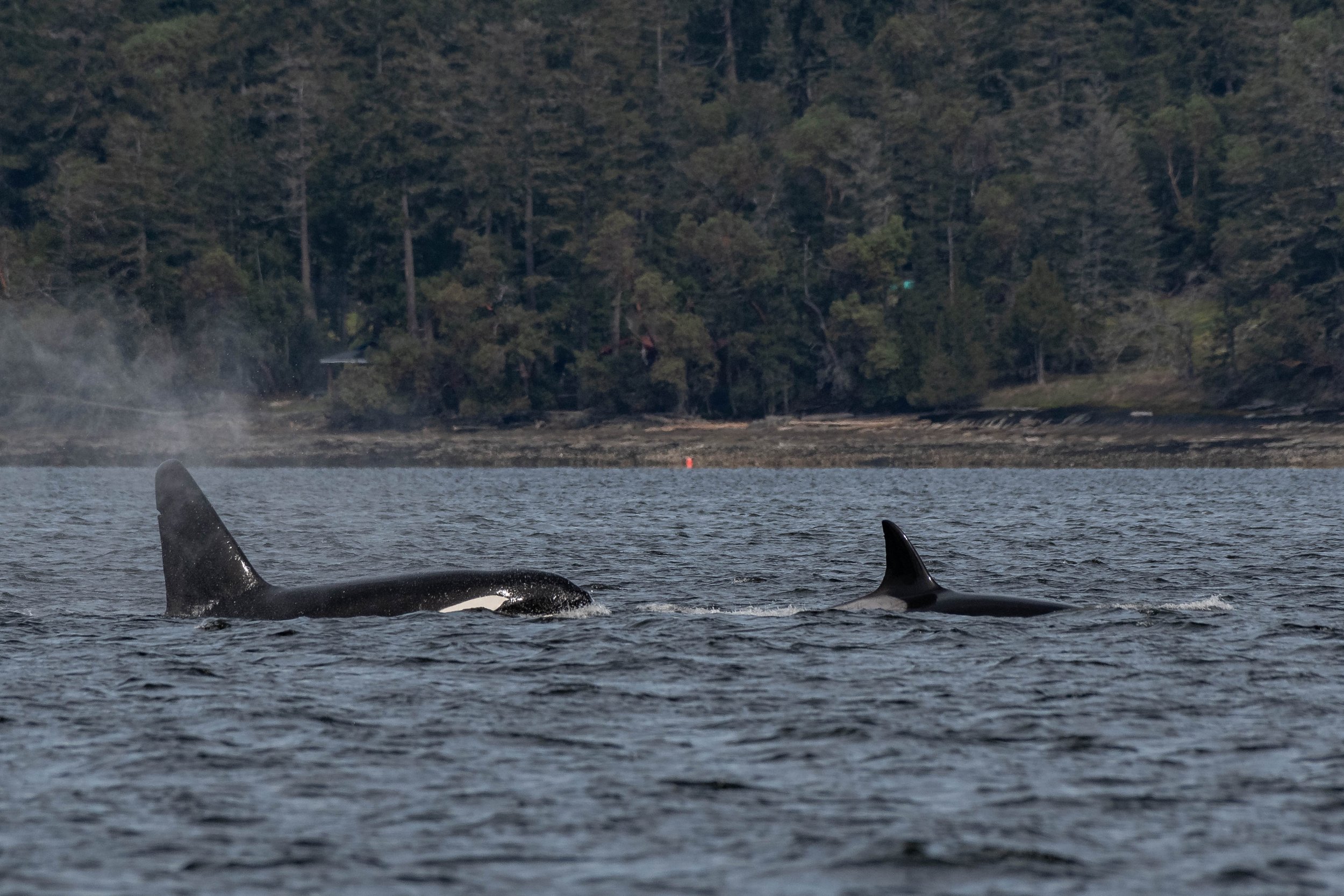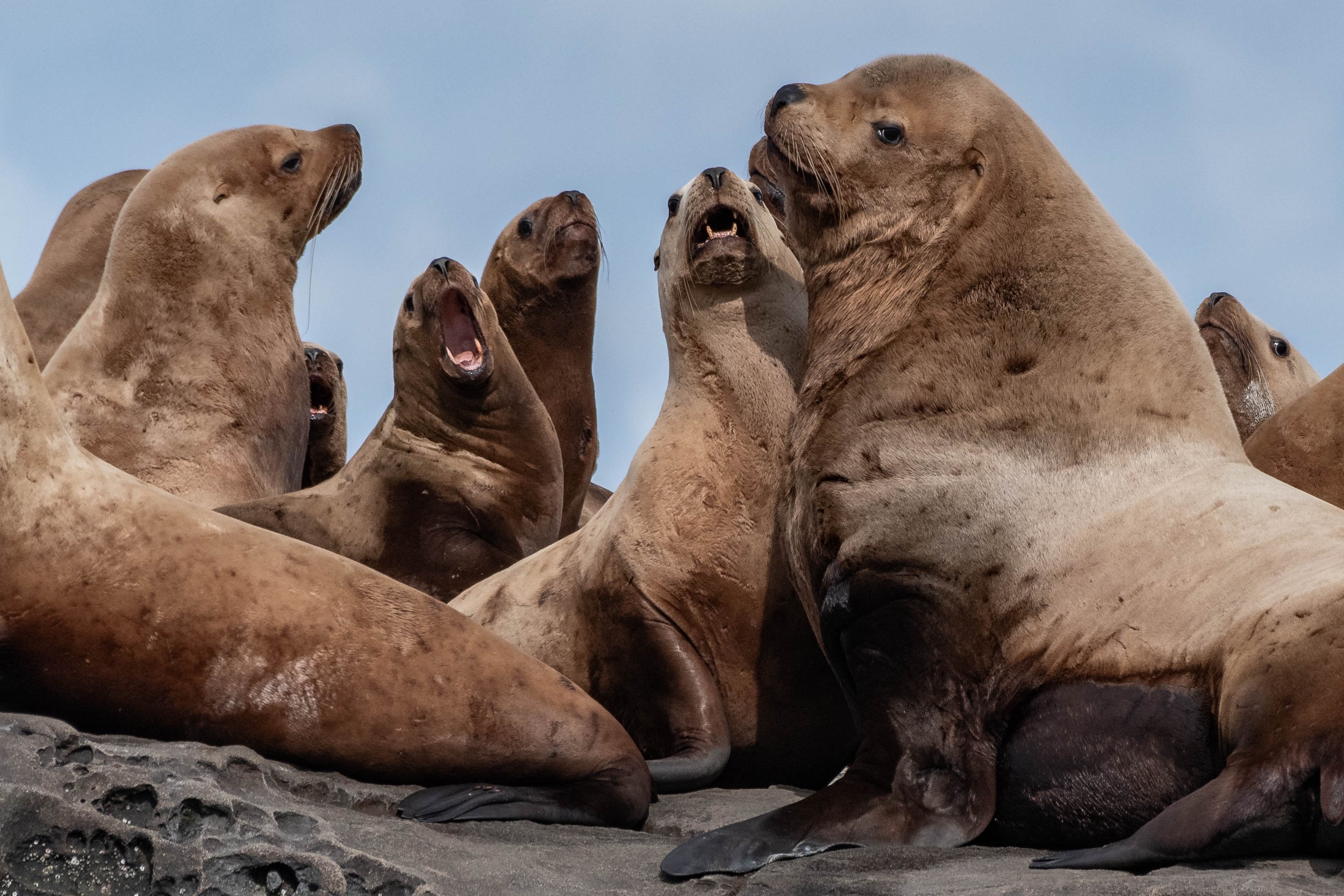March 18, 2025 - The T019s in Stuart Channel
Today felt like spring was in the air, and with the sun shining and a spring in our steps we boarded our semi-covered vessel Kula. On the way we even spotted some of our mischievous river otters disembarking from a boat in the marina, most likely using it as a place to eat or defecate, sometimes both! After laughing at our furry little brats we loaded up and pushed off the dock.
None of our whales are tagged, chipped or tracked so with our eyes peeled we decided to head south and see if we could spot any action in the Gulf Islands. After searching for approximately an hour, we spotted some familiar fins! It was the T019s, consisting of:
T019 Nootka ♀ (~1965)
T019B Galiano ♂ (1995)
T019C Spouter ♂ (2001)
These two males have outstanding dorsal fins that protrude tall out of the water, making them an easy pod to spot! When you think of an orca, one of the most striking features that likely comes to mind is its towering dorsal fin. This impressive fin is not just a visual spectacle; it serves vital functions in the daily lives of these marine mammals. But why do some orca have such massive dorsal fins while others have smaller or even curved ones? Let’s dive into the science behind the orca dorsal fin and explore what makes it such a unique feature.
Structure and Function of the Dorsal Fin
The dorsal fin of an orca is made of dense connective tissue rather than bone. Unlike the pectoral fins, which contain bones similar to those in human hands, the dorsal fin is supported entirely by collagen, a tough and flexible protein. This gives the fin its shape and structure while allowing some flexibility.
Functionally, the dorsal fin acts as a stabilizer, helping the orca maintain balance and maneuver efficiently while swimming at high speeds. It also plays a role in thermoregulation. Orca have a thick layer of blubber, and their dorsal fins help dissipate excess body heat by allowing blood flow near the surface of the skin. This is particularly important for orca living in warmer waters.
Why Do Some Dorsal Fins Grow So Large?
The most impressive dorsal fins belong to adult male orca. These fins can reach staggering heights of up to 6 feet (1.8 meters)—almost as tall as an average human! But why do males grow such enormous fins while females’ dorsal fins typically max out around 3 feet (1 meter)?
The answer lies in sexual dimorphism, a biological phenomenon where males and females of the same species exhibit different physical traits. As male orca reach puberty (around 10-15 years old), their dorsal fins begin to grow dramatically taller and straighter. Scientists believe this is partly a visual signal of maturity and strength, potentially playing a role in social interactions and mate selection.
Curved and Collapsed Dorsal Fins
Not all orca dorsal fins stand tall and straight. Some orca, both in the wild and in captivity, have dorsal fins that curve or collapse entirely to one side. While this can sometimes result from genetics or injury, it is far more common in captive orca. The lack of space, unnatural swimming patterns, and prolonged time at the water’s surface in captivity can contribute to weakened connective tissue, leading to the drooping effect. In the wild, while dorsal fin collapse is rarer, it has been observed in some individuals, often linked to age, stress, or injury. One of the members of this pod, Galiano, is considered to have a collapsed dorsal fin because of the lean at the top of it. The lean or bends in the wild population are more common than a complete collapse. Even with the broader definition, there is still only a estimated 5% of the wild population in the category.
Identifying Orca by Their Dorsal Fins
For whale watchers and researchers alike, the dorsal fin is an invaluable tool for identifying individual orca. Each dorsal fin is unique, with distinct shapes, sizes, and markings, including notches and scars that develop over time. By carefully documenting these features, researchers can track the movements, social structures, and even health of different orca populations.
A Symbol of Strength and Survival
Whether standing tall like a towering sail or curving with time, the dorsal fin remains one of the orca's most defining and awe-inspiring traits. It symbolizes their power, resilience, and adaptability, an essential feature of these magnificent ocean predators.
After spending time with our big boys and their mother we moved on to see some of our other wildlife out enjoying the sunshine! We found some of our favourite little rock sausages, better known as the harbour seal, sunning themselves on the rocks. Take a look at how well they blend into those rocks in the photos below. Next up we heard some of their larger pinniped cousins, and we were treated to seeing both species of sea lions today! Of course, we spotted some bald eagles as well, another favourite of our crew. A great day with so much to see!
Enjoy the photos below taken by Marine Naturalist Aly Kohlman.
This river otter is otterly enjoying the sunshine.
T019C Spouter.
A backlit blow from T019C Spouter.
Can you spot T019 Nootka with her son T019C Spouter?
Right to left: T019 Nootka, T019B Galiano and T019C Spouter.
Right to left: T019 Nootka, T019B Galiano and T019C Spouter. Nootka’s dorsal is around 3 feet tall.
T019C Spouter with T019 Nootka surfacing behind.
T019 Nootka with her son T019B Galiano in tow.
T019 Nootka in the lead, with T019C Spouter behind her and T019B Galiano behind his brother.
Some interesting position from our harbour seals.
Don’t even think about taking my spot on the rocks!
Cute? Who, me?
A lot of Steller sea lions.
No one looks happy in this photo.
A Steller sea lion, can you spot the poop?
Rock climbing!
Almost up there!
We can smell this photo.
A male California sea lion, looking like they woke up on the wrong side of the bed.
A bald eagle soaring high.
It’s a little windy!





















